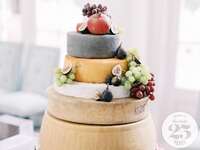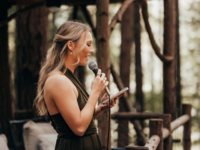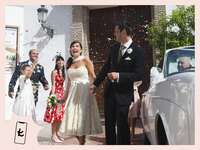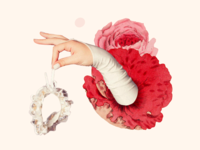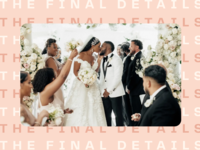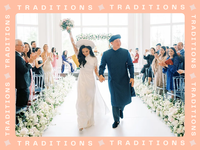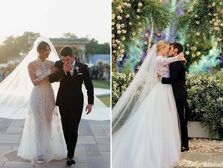The Centuries-Old Ring Warming Ceremony Brings the Luck of the Irish to Your Wedding
From tree planting to knot tying, there are dozens of ways to lend an extra touch of warmth and unity to your wedding day. But one of our favorites is the centuries-old Irish tradition of the ring warming ceremony.
This charming custom brings together every guest at your wedding to ensure you have a lifetime of good wishes and loving intentions. Colleen Cook, Wedding Planner at CCS Events, explains that this Celtic tradition is based on the entire clan of family and friends giving the rings and the couple the warmth of their love. "It is a sign that they are all with you and blessing your marriage," says Cook.
If you want to add this heartfelt tradition and a touch of Irish luck to your wedding, here's how to incorporate a ring warming ceremony into a modern celebration while honoring its centuries-old roots.
- What is a Ring Warming Ceremony?
- Ring Warming Ceremony Script
- Ring Warming Ceremony Origins
- How Long Does a Ring Warming Ceremony Take?
- When to Have the Ring Warming Ceremony
- How to Include Ring Warming in Your Ceremony
What is a Ring Warming Ceremony?
A ring warming ceremony is an old Irish tradition that originated to infuse wedding rings with love and blessings from all of a couple's family and friends. By passing the rings through the hands of every guest, the ring receives good wishes from each and every person in attendance. Before the couple even slips on their wedding bands, they've already been warmed, ready to welcome them into their new life.
Jodie Ward, one half of the husband and wife wedding photographer duo The Sassenachs, explains, "Generally, the wedding rings are brought to the ceremony by a best man or a trusted friend or family member and then are passed around to all the guests."
"Guests are invited to take a moment to each hold the rings and offer their well-wishes or prayers for the couple's future together. This warms the rings with the love and good wishes of the guests," says Ward.
Each guest spends just a few seconds with the rings, and a one member of the ring party keeps the rings traveling throughout the crowd. Ward adds, "A designated person, often someone close to the couple, is made responsible for carrying the rings and to walk around among the guests with them.
Once the rings have been warmed, they are returned to the officiant or the couple, and the ceremony continues until it's time to place the rings on their fingers.
Ring Warming Ceremony Script
Jess Hopkins, Owner of Say Yes With Jess, explains that there are two common scripts for a ring warming ceremony, depending on when you decide to hold the ceremony. If guests warm the rings as they enter then she suggests the officiant say, "Upon entering the ceremony today you were all asked to hold the rings and speak well wishes over them. As these two place these rings on each other's fingers, not only will they carry the commitment they've made to each other daily, but also your support with them."
However, if the ring warming ceremony occurs during the ceremony, Hopkins suggests saying, "Before the two exchange the rings, they would like you to hold them and warm them with well wishes on their union. They want this ceremony to be a reminder for you to hold them accountable for the promises they are making today. As these two place these rings on each other's fingers, not only will they carry the commitment they've made to each other, but also your support with them."
Tara Fay, Dublin-based Wedding Planner at Tara Fay Events, recommends that something personal be incorporated into the ceremony script, which could mean referencing a parent or close family member who cannot be there by also using a piece of jewelry that's important to them. She suggests incorporating a piece of poetry or a reading while the rings are passed.
Fay also adds, "We have passed the rings around with the piece or cord we were using for a handfasting and also an Irish linen and lace hanky. Sometimes couples leave the rings in the box for safety. However, I personally think it's nicer to have the rings passed around without a box." She prefers the idea that guests are physically warming the rings in their hands while sharing an intention or wish. Though she warns guests to watch out for slippery fingers and floor vents.



Ring Warming Ceremony Origins
It's been said that ring warming ceremonies date all the way back to ancient medieval times. "The Irish would require a man to forge rings to present to the woman's family clan. The man forging the rings symbolized his "warming" of the rings, and in order for the union to take place he would have to get the approval of every person in the woman's clan," says Hopkins.
The bride's family would pass the rings around both to approve of the marriage, as well as add their well wishes. If the family member approved, they'd pass the ring with their palm facing up to heaven. "If they disapproved, then they would drop to rings on the ground symbolizing that this union was "to hell" and the wedding would not take place. Fun fact, this is where we get the common phrase 'to hell with it!'," explains Hopkins.
Fay adds that, as with many things in Celtic culture, there's a bit of magic involved. She explains, "In the Irish language we have a word for this, it's called Piseog and often refers to fairy magic or superstitions. In this case, it's passing on the love and best wishes of your loved ones in your new marriage."
How Long Does a Ring Warming Ceremony Take?
Ideally, the ring warming ceremony takes about five minutes, just the length of a song. But, as the wedding party grows, so does the time it can take the ring to make its way through the crowd. While each guest wants to make the most of their time for well wishes. Ward recommends, "We normally suggest that the wedding celebrant makes a wee joke about not keeping hold of the rings too long if it is a larger party."
Fay has a few workarounds for particularly big wedding parties. "You can send one ring on one side and the other ring on the other side. Or the ring can be shared with only the front row or bridal party, or perhaps with the person at the end of each row." It becomes a symbolic passing through of all the guests, rather than literally letting each guest hold the ring.
However, there are sometimes exceptions to be made when you're considering who gets to warm the rings at a big wedding. "It's particularly sweet to see the kids who are at the wedding 'warming' the rings. It's lovely as you see their little faces concentrate as they think about their well-wishes or prayers," says Ward.
When to Have the Ring Warming Ceremony
A ring ceremony can either occur as guests walk into the ceremony or it can occur during the ceremony, before the rings are exchanged.
Hopkins says, "If guests are warming the rings upon entering the ceremony site, then there should be a sign explaining what to do and a box that the rings will sit in or stand that the rings will hang from on a string."
Typically, if the ring warming ceremony is held during the ceremony, then there is a song that accompanies the passing of the rings. This keeps the rings moving since the pressure is on to pass them before the music is up.
If you plan on including multiple Irish traditions in your big day, Fay suggests, "Most of our celebrants incorporate the ring warming before the handfasting element. Both are old Celtic traditions. It's about sharing the love the guests have for the couple directly with the couple through the rings."
How to Include Ring Warming in Your Ceremony
If you plan to incorporate a ring warming into your ceremony, prepare to explain it to your guests so they understand the meaning and sentimental feelings behind the tradition. In the United States, most guests may not be aware of what a ring warming is or why it's done. A short blurb in your program could add context, and you can ask your officiant to take a moment to dive into the custom, its history, and how the guests can participate.
For guests who are used to sitting back and observing, they'll be delighted to have such a heartwarming way to be included in your celebration.




